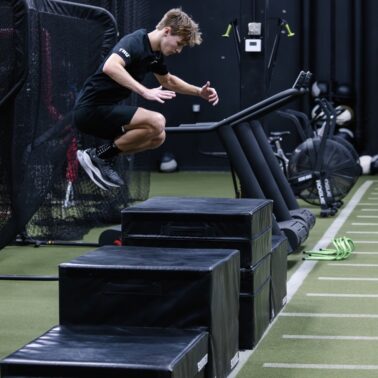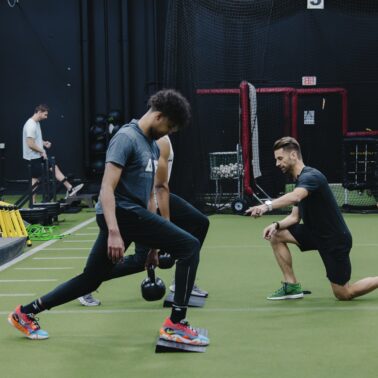Approximate Read Time: 12 minutes
“Velocity based training doesn’t just measure speed—it reveals readiness, intent, and capacity.”
What You will learn
- Velocity Based Training (VBT) uses movement speed to tailor and regulate load.
- It’s an essential tool for both rehab and high performance when precision matters.
- The force-velocity curve guides targeted adaptations: strength, speed, or power.
- Profiling athletes using movement velocity helps personalize training plans.
- VBT ensures tissue safety, progression, and load integrity in return-to-play
What If You Could See Readiness in Real Time?
In rehab and performance, timing is everything. Knowing when to push, when to pull back, and how to load with purpose is critical—especially after injury. Velocity-Based Training (VBT) bridges the gap between intention and execution by offering real-time feedback on how an athlete is moving. Whether you’re in a high-performance setting or guiding an athlete through post-op strength work, VBT tells you what your eyes can’t always see.
This guide unpacks how VBT works, how to profile athletes (think Kangaroo vs. Gorilla), and how to apply velocity thresholds across the rehab-to-performance continuum.
The Force-Velocity Curve: Your Map for Athletic Qualities
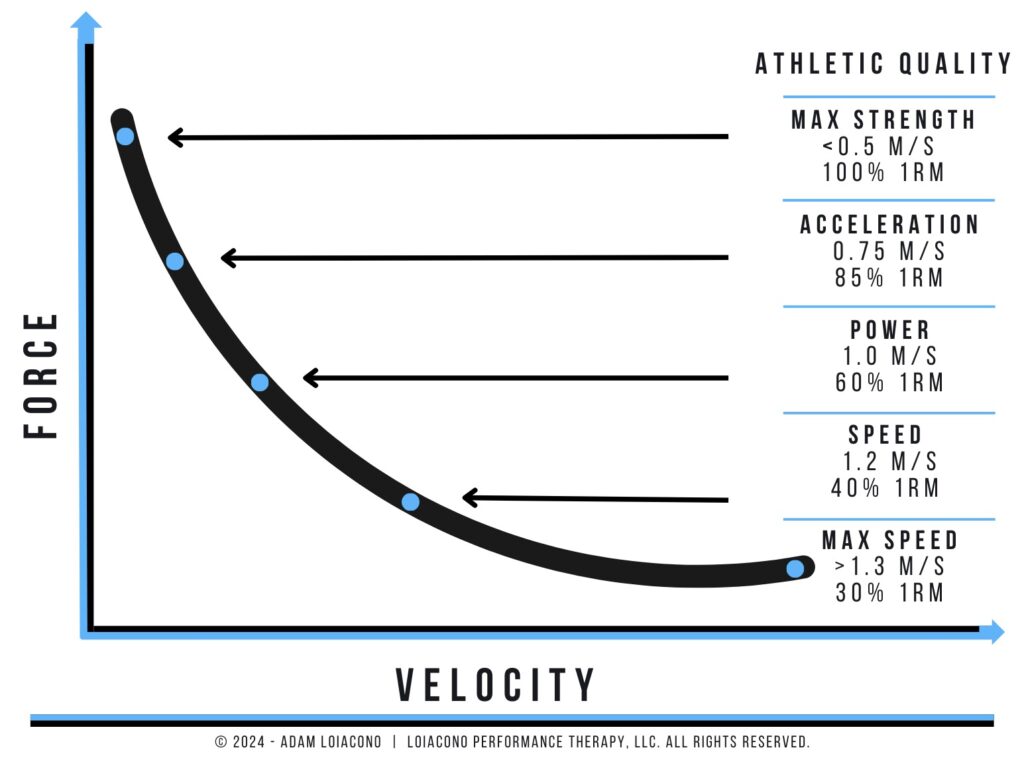
The force-velocity curve explains the inverse relationship between load and movement speed:
- High force = Low velocity (e.g., heavy squats)
- Low force = High velocity (e.g., sprinting, jumping)
Training different points along this curve targets distinct adaptations:
| Velocity Zone | Speed Range | Focus |
|---|---|---|
| Absolute Strength | < 0.5 m/s | Maximal force, neural drive |
| Acceleration Strength | 0.5–0.75 m/s | Force under time constraint |
| Strength-Speed | 0.75–1.0 m/s | Power expression under load |
| Speed-Strength | 1.0–1.3 m/s | Explosive force with light load |
| Starting Strength | > 1.3 m/s | Overcoming inertia, reactivity |
“The curve tells us more than output—it tells us how we got there.”
Using the force-velocity curve as a rehab tool allows us to systematically restore athletic qualities that were lost post-injury.
Beyond %1RM: Why VBT Is Better for Rehab
Traditional loading strategies rely on percentages of a 1-rep max. But an athlete’s true 1RM can fluctuate by 10–20% depending on fatigue, nutrition, and mental readiness. VBT introduces real-time autoregulation by measuring actual movement speed.
Benefits include:
- Objective monitoring of intent and effort
- Autoregulated progression that respects tissue healing
- Daily insight into how athletes are adapting or regressing
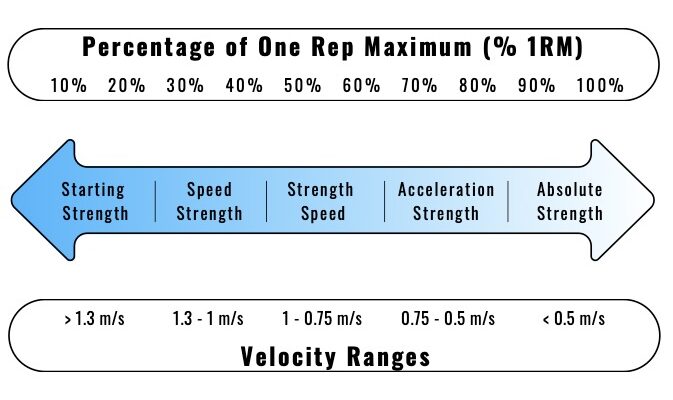
Tools like Output and Gymaware can provide velocity data for a wide variety of movements—barbell, cable, kettlebell, or even medicine ball.
“In rehab, speed is more than a metric—it’s a safety check.”
Using VBT Across the Rehab Continuum

Step 1: Start with Strength
After injury, force capacity is always diminished. Athletes need time under load to reestablish foundational strength. Begin with slow, heavy efforts that fall under the Absolute Strength zone (< 0.5 m/s). Think trap bar deadlifts, slow tempo squats, and heavy sled pushes.
Step 2: Progress to Acceleration and Power
Once base strength is restored, shift toward Acceleration Strength (0.5–0.75 m/s) and Strength-Speed (0.75–1.0 m/s). This includes:
- Dynamic effort lifts
- Banded or chain-loaded squats
- Controlled med ball throws
Step 3: Peak with Speed-Strength and Reactivity
Finally, prepare for sport demands with high-velocity work:
- Jump squats or speed squats (1.0–1.3 m/s)
- Drop jumps, A-skips, or sled sprint drills (>1.3 m/s)
“The goal isn’t just to return—it’s to return at game speed.”
Athlete Profiling: Kangaroos vs. Gorillas
Different athletes express force and speed differently. VBT allows us to classify athletes:
- Kangaroos: High-velocity movers, elastic, but often lack force
- Gorillas: Strong, force-dominant, but struggle with speed or reactivity
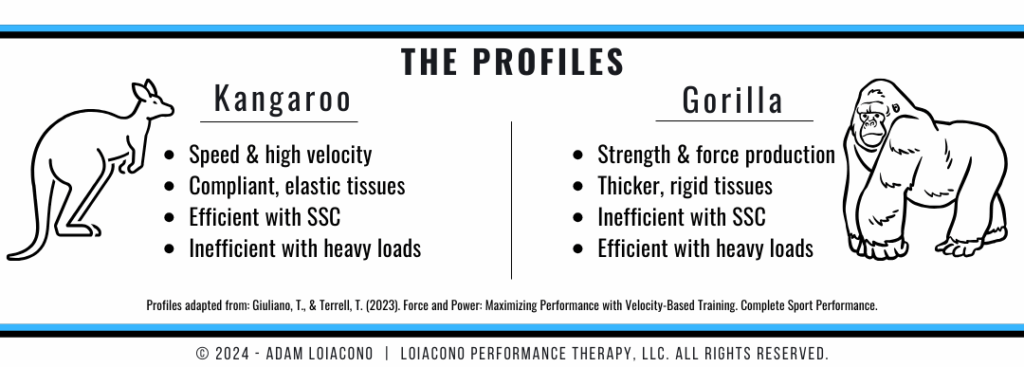
Programming Implications
- Kangaroos benefit from eccentric tempo work, heavy lifts, and tissue adaptation
- Gorillas need ballistic training, plyometrics, and speed-focused lifts
Use VBT to find each athlete’s bias, then design loading that challenges—not suppresses—their physiology.
“Train the gaps—but protect the gifts.”
Bands vs. Chains: Load Tools for VBT
Chains:
- Resistance increases as lift ascends
- Targets force production at end range
- Helps with maximal strength
Bands:
- Resistance increases with speed and range
- Requires acceleration throughout the lift
- Enhances rate of force development and peak power
Both are essential VBT tools—but they serve different phases and adaptations
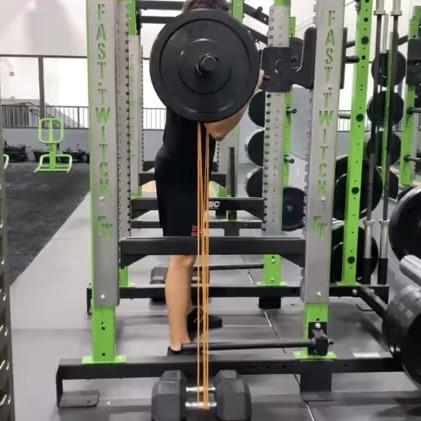

Integrating VBT with Locomotion Progressions
VBT doesn’t just belong in the weight room. It pairs seamlessly with return-to-run and plyometric progressions:
- Use Absolute Strength training to prepare tissues for loading and stiffness.
- As athletes reintroduce bounding, jumping, and acceleration drills, shift weight room efforts to Strength-Speed and Speed-Strength zones.
This coherence ensures all stressors—weight room, field, and therapy—are working toward the same goal.
“Force is the foundation. Velocity brings it to life.”
Final Thoughts: VBT Is More Than a Number
Velocity-Based Training offers real-time feedback, daily autoregulation, and an athlete-specific path through rehab. It makes rehab smarter—not just safer.
When you can see how fast an athlete moves a load, you know:
- How hard they’re working
- How much they’re recovering
- Whether they’re ready to go harder—or need to dial it back
For rehab professionals, VBT is no longer optional. It’s the standard.
Recommended Podcast
- Finding Small Wins: Bridging Biomechanics and Physiology ft. Mike Young, PhD
- Finding Small Wins: Muscle, Mind, and Mastery ft. Pat Davidson, PhD
Similar Articles
- Revisiting High Performance Rehab for Tendinopathies
- Criteria vs. Biology in Return to Play: A Comprehensive Analysis
References
- Giuliano, T., & Terrell, T. Force and Power: Maximizing Performance with Velocity-Based Training, Complete Sport Performance, 2023

